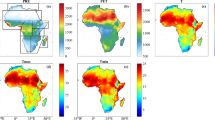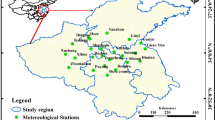Abstract
The trend of temperature and homogeneity are the most significant issue for climate change allied research. This research aims to identify the long-term trend and change point detection of winter maximum (tmax), minimum (tmin) and average (tmean) temperature of six meteorological stations of North Bengal, India using 102 years’ time series data (1915–2016). To detect the monotonic trend and the rate of change, non-parametric Mann–Kendall (MK) test and Sen’s slope estimator were used. Homogeneity of winter temperature was studied using Buishand’s range test (B test) and Pettit’s test (P test). From the results, it was observed that most of the stations were showed significant (P < 0.05) warming trend in winter season. The rate of increasing was highest at station English Bazar in the month of December. On the other hand, significant changed of winter tmax and tmean occurred in around 1959 and 1952 respectively, while for tmin it was quite late, occurred in the year 1988. The populations of North Bengal who are dependent on temperature-related primary economic activities are getting benefitted from this study. In addition, these analyses will be helpful for policymakers and scientist to focus on micro-level planning and sustainable Rabi crops management in this region.






Similar content being viewed by others
References
Barry, R. G., & Chorley, R. J. (2010). Atmosphere, weather and climate. London: Routledge.
Singh, S. (2016). Climatology. Allahabad: Pravalika Publication.
Khan, A., Chatterjee, S., & Bisai, D. (2017). Air temperature variability and trend analysis by non-parametric test for Kolkata observatory, West Bengal, India. Indian Journal of Geo Marine Sciences, 46(5), 966–971.
Jaswal, A. K. (2010). Recent winter warming over India-spatial and temporal characteristics of monthly maximum and minimum Temperature trends for January to march. Mausam, 61(2), 163–174.
Raha, G. N., Bhattacharjee, K., Das, M., Dutta, M., & Bandyopadhyay, S. (2014). Statistical study of surface temperature and rainfall over four stations in north Bengal. Mausam, 62(2), 179–184.
Hunter, D. E., Schwartz, S. E., Wagener, R., & Benkovitz, C. M. (1993). Seasonal, latitudinal, and secular variations in temperature trend: Evidence for influence of anthropogenic sulfate. Geophysical Reseach Letters, 20, 2455–2458.
Dammo, M. N., Ibn Abubakar, B. S. U., & Sangodoyin, A. Y. (2015). Trend and change analysis of monthly and seasonal temperature series over North-eastern Nigeria. Journal of Geography, Environment and Earth Science International, 3(2), 1–8.
Pramanik, S. K., & Jagannathan, P. (1954). Climate change in India (II)-temperature. Indian Journal of Meteorology & Geophysics, 5(1), 29–47.
Hingane, L. S., Rupa Kumar, K., & Ramana Murty, Bh. V. (1985). Long-term trends of surface air temperature in India. Journal of Climatology, 5, 521–528.
Arora, M., Goel, N. K., & Singh, P. (2005). Evaluation of temperature trends over India. Hydrological Sciences Journal, 50(1), 81–93.
Dash, S. K., Jenamani, R. K., Kalsi, S. R., & Panda, S. K. (2007). Some evidence of climate change in twentieth-century India. Climatic Change, 85, 299–321.
Mandal, S., Choudhury, B. U., Mandal, M., & Bej, S. (2013). Trend analysis of weather variables in Sagar Island, West Bengal, India: a long-term perspective (1982–2010). Current Science, 105(7), 947–953.
Jain, S. K., Kumar, V., & Saharia, M. (2012). Analysis of rainfall and temperature trends in northeast India. International Journal of Climatology, 5, 5. https://doi.org/10.1002/joc.3483.
Oza, M., & Kishtawal, C. M. (2014). Trends in rainfall and temperature patterns over northeast India. Earth Science, India, 7(4), 90–105.
Tomar, C. S., Saha, D., Das, S., Saw, S., Bist, S., & Gupta, M. K. (2017). Analysis of temperature variability and trends over Tripura. Mausam, 68(1), 149–160.
Kumar, K., Mishra, N., & Gupta, S. (2014). Trend analysis of temperature by Mann–Kendall test in the high altitude regions of Uttarakhand, India. Asian Academic Research Journal of Multidisciplinary, 1(18), 387–399.
Chen, H., Guo, S., Xu, C. Y., & Singh, V. P. (2007). Historical temporal trends of hydro-climatic variables and run-off response to climate variability and their relevance in water resource management in the Hanjiang Basin. Journal of Hydrology, 344, 171–184.
Suhaila, J., Jemain, A. A., Hamdan, M. F., & Zin, W. Z. W. (2011). Comparing rainfall patterns between regions in Peninsular Malaysia via a functional data analysis technique. Journal of Hydrology, 411(3), 197–206. https://doi.org/10.1016/j.jhydrol.2011.09.043.
Firat, M., Dikbas, F., Koc, A. C., & Gungor, M. (2012). Analysis of temperature series: estimation of missing data and homogeneity test. Meteorological Applications, 19, 397–406. https://doi.org/10.1002/met.271.
Omar, M. A., Mahmood, A. S., Cagatay, B., & Nermin, S. (2017). Homogeneity analysis of precipitation series in North Iraq. IOSR Journal of Applied Geology and Geophysics, 5(3), 57–63.
Akinsanola, A. A., & Ogunjobi, K. O. (2015). Recent homogeneity analysis and long-term spatio-temporal rainfall trends in Nigeria. Theoretical and Applied Climatology, 128, 275. https://doi.org/10.1007/s00704-015-1701-x.
Easterling, D. R., & Peterson, T. C. (1995). A new method for detecting undocumented discontinuities in climatological time series. International Journal of Climatology, 15, 369–377.
Mann, H. B. (1945). Non parametric tests against trend. Econometrica, 13, 245–259.
Kendall, M. G. (1975). Rank correlation methods. London: Griffin.
Odoulami, R. C., & Akinsanola, A. A. (2017). Recent assessment of West African summer monsoon daily rainfall trends. Weather, 5, 5. https://doi.org/10.1002/wea.2965.
Das, J., & Bhattacharya, S. K. (2018). Trend analysis of long-term climatic parameters in Dinhata of Koch Bihar district, West Bengal. Spatial Information Research, 5, 1–10. https://doi.org/10.1007/s41324-018-0173-3.
Pearson, E. S., & Hartley, H. O. (1966). Biometrika tables for statisticians (3rd ed., Vol. 1). London: Cambridge University Press.
Wijngaard, J. B., Klein Tank, A. M. G., & Konnen, G. P. (2003). Homogeneity of 20th century European daily temperature and precipitation series. International Journal of Climatology, 23, 679–692.
Buishand, T. A. (1982). Some methods for testing the homogeneity of rainfall records. Journal of Hydrology, 58, 11–27.
Pettitt, A. N. (1979). A non-parametric approach to the change-point detection. Applied Statistics, 28, 126–135.
Sen, P. K. (1968). Estimates of the regression coefficient based on Kendall’s tau. Journal of the American Statistical Association, 63, 1379–1389.
Gilbert, R. O. (1987). Statistical methods for environmental pollution monitoring. Hoboken: Wiley.
Jangra, S., & Singh, M. (2011). Analysis of rainfall and temperatures for climatic trend in Kullu valley. Mausam, 62(1), 77–84.
Jain, S. K., & Kumar, V. (2012). Trend analysis of rainfall and temperature data for India. Current Science, 102(1), 37–49.
Warwade, P., Sharma, N., Ahrens, B., & Pandey, A. (2015). Characterization and analysis of the trend of climate variable (Temperatures) for the North-Eastern region of the India. International Journal of Recent Scientific Research, 6(4), 3618–3624.
Shrestha, A. B., Wake, C. P., Mayewski, P. A., & Dibb, J. E. (1999). Maximum temperature trends in the Himalaya and its vicinity: an analysis based on temperature records from Nepal for the period 1971–94. Journal of Climate, 12(9), 2775–2786.
Domroes, M., & El-Tantawi, A. (2005). Recent temporal and spatial temperature changes in Egypt. International Journal of Climatology, 25(1), 51–63.
Gbode, I. E., Akinsanola, A. A., & Ajayi, V. O. (2015). Recent changes of some observed climate extreme events in Kano. International Journal of Atmospheric Sciences. Article ID 298046. http://dx.doi.org/10.1155/2015/298046.
Jacob, D., & Walland, D. (2016). Variability and long-term change in Australian temperature and precipitation extremes. Weather and Climate Extremes, 14, 36–55.
Acknowledgements
The authors are grateful to the India Water Portal for providing free download of various dataset used in the analysis. Also, the authors would like to thank anonymous reviewers and editor for their helpful comments on the previous version of the manuscript.
Author information
Authors and Affiliations
Corresponding author
Ethics declarations
Conflict of interest
The authors declare that they have no conflict of interest.
Ethical approval
This paper does not contain any studies with human participants performed by any of the authors. This paper does not contain any studies with animals performed by any of the authors.
Rights and permissions
About this article
Cite this article
Das, J., Mandal, T. & Saha, P. Spatio-temporal trend and change point detection of winter temperature of North Bengal, India. Spat. Inf. Res. 27, 411–424 (2019). https://doi.org/10.1007/s41324-019-00241-9
Received:
Revised:
Accepted:
Published:
Issue Date:
DOI: https://doi.org/10.1007/s41324-019-00241-9




